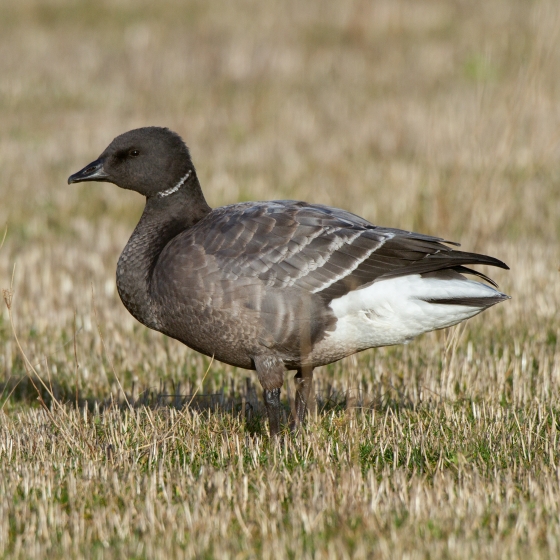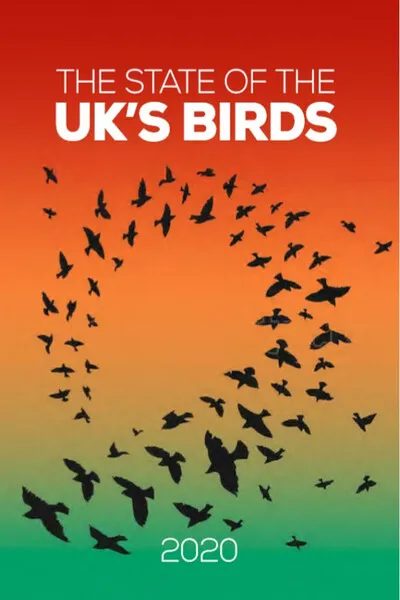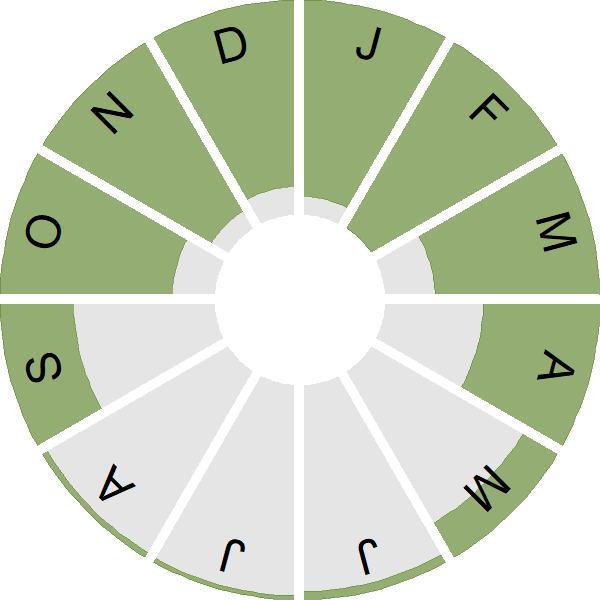Brent Goose

Introduction
Brent Geese are locally numerous winter visitors to Britain & Ireland, found on saltmarshes and adjoining grassy habitats around most of the coast.
Britain & Ireland host individuals from four separate breeding populations. The two Light-bellied Brent Goose populations – from Canada and Svalbard – largely winter on Strangford Lough and Lindisfarne respectively, while the birds wintering elsewhere in Britain come from the Russian Dark-bellied population. A few Black Brants, from Siberia, Alaska or Canada, are recorded most years.
Wintering numbers increased strongly through the 1970s and 1980s, and have fluctuated around this higher level since.

Key Stats
Identification
Songs and Calls
Song:
Call:
Status and Trends
Conservation Status
Population Change
The UK plays host to two subspecies of Brent Goose in winter. The Dark-bellied Brent Goose (bernicla) winters predominantly in England, from the Humber Estuary southwards, along the eastern and southern coasts; small numbers can also be found in Wales and northwest England. There are two distinct populations of the Light-bellied Brent Goose (hrota); the Svalbard population mostly winters at Lindisfarne, with smaller numbers at other sites in northeast England and southeast Scotland, while the Canadian population winters mostly in Northern Ireland (particularly on Strangford Lough), with smaller numbers also found on the north and west coasts of Scotland. The population of Dark-bellied Brent Geese increased considerably from the late 1960s to a peak in the mid-1990s, after which it declined, before recovering by the mid-2010s; in more recent years numbers wintering in the UK have started to drop once again. In recent times, numbers of the Svalbard population of Light-bellied Brent Geese peaked in the winter of 2010/11 following a steady increase since monitoring for this species through WeBS began in the 1960s. Since then, numbers have declined by approximately a quarter. In contrast to the other two, the Canadian Light-bellied Brent Goose population has increased steadily since the mid-1980s, albeit with some fluctuations in recent years which reflect the numbers recorded in Northern Ireland.
Distribution
Brent Geese were recorded in winter from almost the entire coastline of Britain & Ireland, except for north and west Scotland. This overall distribution conceals separate patterns for birds from three different breeding populations. The Canadian Light-bellied population winters predominantly in Ireland. Birds from the Svalbard Light-bellied Brent Goose population winter in Denmark and in Britain, where they winter predominantly around Lindisfarne in Northumberland. The bulk of the Brent Geese that winter elsewhere in Britain are from the arctic Russian-breeding Dark-bellied population.
Occupied 10-km squares in UK
or view it on Bird Atlas Mapstore.
or view it on Bird Atlas Mapstore.
European Distribution Map
Distribution Change
Change in occupied 10-km squares in the UK
or view it on Bird Atlas Mapstore.
Seasonality
Brent Goose are common winter visitors to coastal areas, arriving through September. Most birds depart in April but some flocks can remain into May.
Weekly pattern of occurrence
The graph shows when the species is present in the UK, with taller bars indicating a higher likelihood of encountering the species in appropriate regions and habitats.

Movement
Britain & Ireland movement
Foreign locations of birds ringed or recovered in Britain & Ireland
Dots show the foreign destinations of birds ringed in Britain & Ireland, and the origins of birds ringed overseas that were subsequently recaptured, resighted or found dead in Britain & Ireland. Dot colours indicate the time of year that the species was present at the location.
- Winter (Nov-Feb)
- Spring (Mar-Apr)
- Summer (May-Jul)
- Autumn (Aug-Oct)

European movements
EuroBirdPortal uses birdwatcher's records, such as those logged in BirdTrack to map the flows of birds as they arrive and depart Europe. See maps for this species here.
The Eurasian-African Migration Atlas shows movements of individual birds ringed or recovered in Europe. See maps for this species here.
Biology
Productivity and Nesting
Nesting timing
Egg measurements
Clutch Size
Fledging
Survival and Longevity
Survival is shown as the proportion of birds surviving from one year to the next and is derived from bird ringing data. It can also be used to estimate how long birds typically live.
View number ringed each year in the Online Ringing Report.
lifespan
Survival of adults
Biometrics
Wing length and body weights are from live birds (source).
Wing length
Body weight
Ring Size
Classification, names and codes
Classification and Codes
- Order: Anseriformes
- Family: Anatidae
- Scientific name: Branta bernicla
- Authority: Linnaeus, 1758
- BTO 2-letter code: BG
- BTO 5-letter code: BREGO
- Euring code number: 1680
Alternate species names
- Catalan: oca de collar
- Czech: berneška tmavá
- Danish: Knortegås
- Dutch: Rotgans
- Estonian: mustlagle
- Finnish: sepelhanhi
- French: Bernache cravant
- Gaelic: Gèadh-got
- German: Ringelgans
- Hungarian: örvös lúd
- Icelandic: Margæs
- Irish: Cadhan
- Italian: Oca colombaccio
- Latvian: melngalvas zoss
- Lithuanian: paprastoji bernikle
- Norwegian: Ringgås
- Polish: bernikla obrozna
- Portuguese: ganso-de-faces-pretas
- Slovak: bernikla tmavá
- Slovenian: grivasta gos
- Spanish: Barnacla carinegra
- Swedish: prutgås
- Welsh: Gwydd Ddu
- English folkname(s): Brant, Quink
Research
Causes of Change and Solutions
Causes of change
The increase in the Dark-bellied Brent Goose population between the mid-1950s and late 1980s has been attributed to a high survival rate for individuals over six months old and a pattern of high breeding success once or twice every three years [Summers & Underhill 1991]. Ebbinge et al. [2002] argue that availability of suitable nesting habitat is also an important factor influencing reproductive potential and that while density-dependent factors were significant in influencing reproduction, they do not impact adult survival. The subsequent decline in the Dark-bellied Brent Goose population has been attributed to poor breeding in years of low lemming abundance on the breeding ground; lemmings are the main food source for the potential predators of goslings [Ebbinge et al. 2013].
The Svalbard Light-bellied Brent Goose population numbered 50,000 before a disease of its principal food source (Zostera marina) and/or human over-exploitation caused numbers to crash in the first half of the 20th century [Denny et al. 2004]. Numbers were further reduced to c.2,000 individuals in the 1960s, likely as a result of overhunting on the Danish wintering grounds; since the population was protected in Denmark in 1972, numbers increased to 8–10,000 during 2010–16 [Madsen et al. 2019]. At its height, at least 20,000 birds wintered in Britain but this number had declined to c.1,600 by the mid 1960s, after which numbers increased [Denny et al. 2004].
The global Canadian Light-bellied Brent Goose population increased rapidly in the early 1980s, thanks to a series of successful breeding seasons; low productivity in the 1990s caused the population to crash but several years of high productivity saw the population increase markedly by the early 2000s [Robinson & Colhoun 2006]. In Ireland, in addition to changes in productivity rates, the apparent increase and decrease in numbers in mid 1980s and mid 1990s respectively may, in part, have been the result of changes in counter effort [Robinson et al. 2004].
Publications (1)
The State of the UK's Birds 2020
Author: Burns, F., Eaton, M.A., Balmer, D.E., Banks, A., Caldow, R., Donelan, J.L., Douse, A., Duigan, C., Foster, S., Frost, T., Grice, P.V., Hall, C., Hanmer, H.J., Harris, S.J., Johnstone, I., Lindley, P., McCulloch, N., Noble, D.G., Risely, K., Robinson, R.A. & Wotton, S.
Published: 2020
The State of UK’s Birds reports have provided an periodic overview of the status of the UK’s breeding and non-breeding bird species in the UK and its Overseas Territories since 1999. This year’s report highlights the continuing poor fortunes of the UK’s woodland birds, and the huge efforts of BTO volunteers who collect data.
17.12.20
Reports State of Birds in the UK


